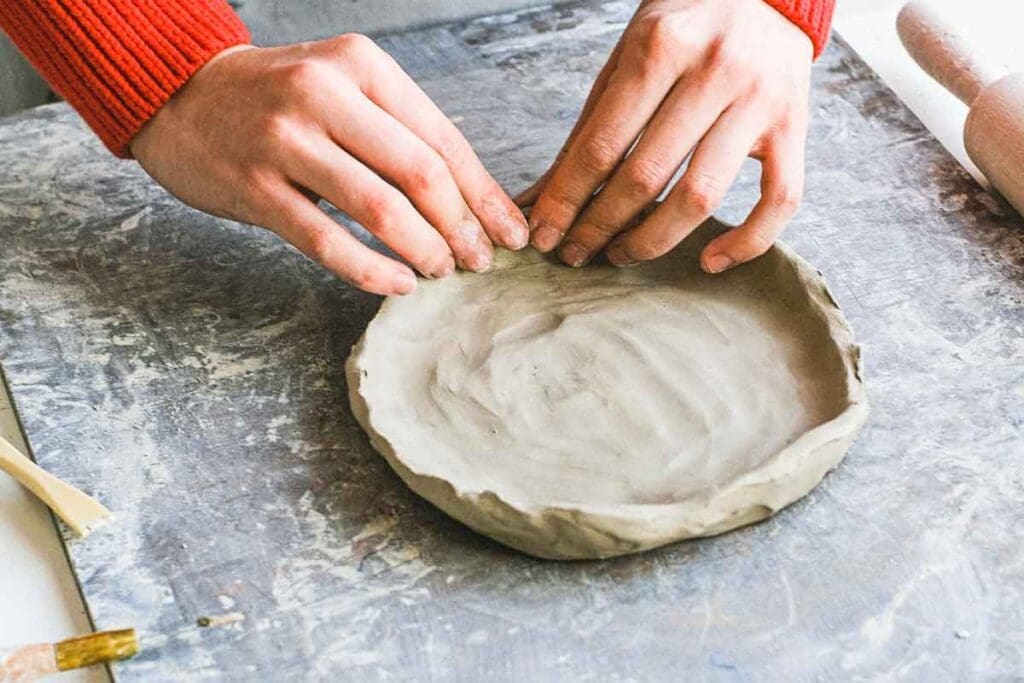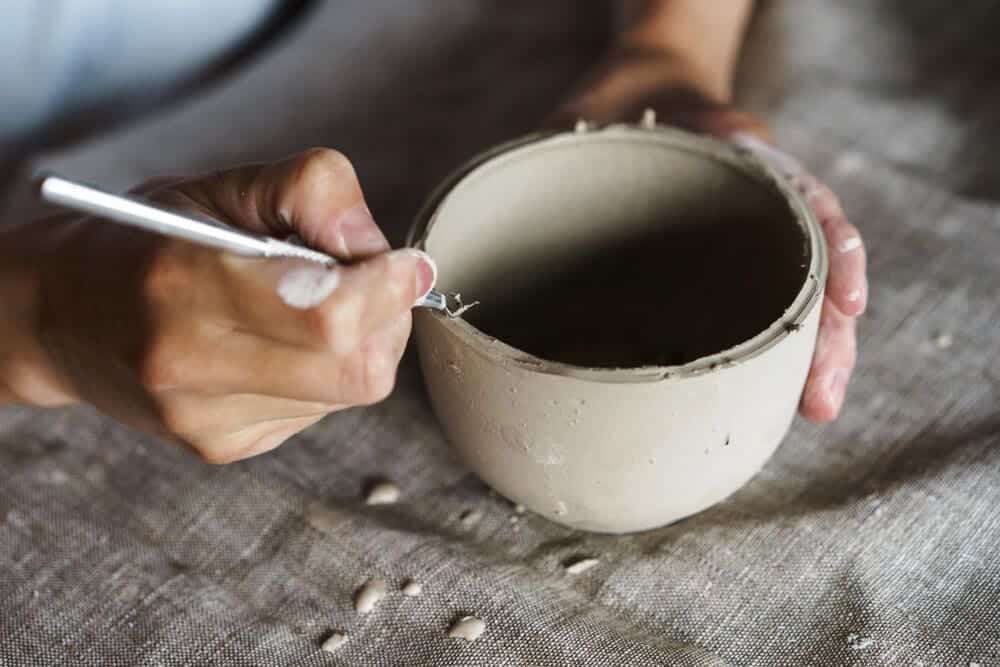Ceramic, porcelain, and stoneware production have six primary stages that most clay production will go through. Depending on your product, it can change slightly, but most basic clay production will go through these six steps.
For almost all ceramic, porcelain, and stoneware production, there are six basic steps that the clay must go through. In the ceramic production process, the clay needs to go from a liquid form to be fired into a rigid, nonporous shape.
Table of Contents
The Six Basic Stages Of Clay Production Explained
If you purchase ceramics, it is good to understand the different stages of clay production. Knowing some fundamental processes or products most clay will go through for production is essential to an understanding of clay product development.
Here are the six basic stages of clay production explained:
Slip Clay Stage Of Clay
Slip clay is clay with added water to make it a liquid or a paste. This clay is often used to pour into a mold so that the mold can dry.

The clay used for a mold can be known as slip casting, as the clay is poured into the mold to mold a shape.
Slip clay can be used for the following:
- Pour Into A Mold – Slip clay or liquid clay can be poured into a mold to help shape an item.
- Used To Join Pieces – Slip clay can be used to join pieces of wet clay together.
- Color – Slip clay can have color added to it to give color to the clay. We use this method a lot for any agateware clay pieces we produce.
- Chemicals – Chemicals can also be added to slip clay to make it runnier.
Wet Clay Stage Of Clay

The wet clay stage is known simply as ”wet.” or as ”fresh clay.” For clay to be used for any production, the clay must be wet.
That is why when you go into a ceramic or porcelain factory, you will find that the one material they will protect and ensure is kept wet is the clay. This is also why they may not mix the clay and store it for a long time, as they do not want to mix clay that can dry out since, for them to work with the clay, they need to ensure the clay is wet.
In this stage, here are a few things you need to ensure happens:
- Malleable – The clay needs to be malleable so it can be shaped.
- Hold Shape – The clay needs to be able to hold the shape. Being able to hold the shape is essential in any ceramic production.
It may be a problem if your clay dries out or is even partly dry, so it is essential to keep it wet and malleable.
Leather Hard Stage Of Clay

The leather hard stage of clay is when the wet or slip clay has dried slightly. The clay is not fully dry and cannot yet be put in the kiln, but the clay is about to hold some shapes.
The, the clay must still be wet enough to be put into shape at the leather hard clay stage.
Here are a few things to remember about leather hard clay:
- Leather hard clay is strong enough so that the clay can be shaped.
- Pots thrown on the wheel must be strong enough to keep their shape.
- You can do some carving in the clay and the clay will still hold its shape.
- Flat slabs of clay can be put together to make 3-D structures.
The Dry Stage Of Clay

The Dry Stage of clay is also known as greenware. Greenware is when the clay is most fragile, and if not handled correctly, the shape and clay can easily crack or break.
Here are a few things to know about the dry stage of clay:
- Final finishing is done to the clay; this is the last part of the shape before firing.
- A damp sponge is taken to the shape, and areas can be smoothed out.
- The clay shape is getting ready to be fired in the kiln.
Bisque Stage Of Clay
Bisque refers to the clay that has been fired once. Many kinds of ceramics are fired at least twice.
For stoneware, the firing will need to reach at least 950 C or 1742 F; ceramic and porcelain will be fired at higher temperatures.
During this stage, the nature of the clay will permanently change. The clay becomes rigid, but it is not hard enough to be able to glaze the base.
Here are a few things about this stage of clay production:
- Once the clay is fired, then clay is now easier to work with.
- The glaze is put on the clay for the final step at this stage.
- Water can also be absorbed into the clay as the clay is not yet completely hardened.
Glaze Ware Stage Of Clay
The final step of most clay production is that the clay is then fired or glazed a second time. When the clay is fired, the clay and glaze will fuse to make a nonporous surface.
Here are a few things about the glaze ware stage of the clay:
- This is the usually final stage of clay production.
- Ideally, the glaze should be even and fire without defects depending on the look you want for your product.
As you can see from these steps, all kinds of stoneware, ceramic, and porcelain production must go through these basic steps. The main point is to ensure the clay goes from a completely liquid substance to a piece of pottery that is hard and nonporous.
At Mondoro, we can help you produce all kinds of ceramics, porcelain, and stoneware products.
Find out more about how Mondoro can help you create, develop, and manufacture excellent home decor and furniture products – don’t hesitate to contact me, Anita. Check out my email by clicking here or become a part of our community and join our newsletter by clicking here.
Mondoro gives out a FREE Lookbook to anyone interested. You can receive a copy of our latest Lookbook by clicking here.
Listen to our Podcast called Global Trade Gal. You can find it on all major podcast platforms. Try out to listen to one of our podcasts by clicking here.
Subscribe to our Mondoro Company Limited YouTube Channel filled with great videos and information by clicking here.
Frequently Asked Questions
1. What are the six basic stages of clay and ceramic production?
The six basic stages of clay and ceramic production are mining, preparation, forming, drying, firing, and glazing.
2. What happens during the mining stage?
During the mining stage, raw materials like clay, feldspar, and silica are extracted from the earth.
3. What is the purpose of the preparation stage?
In the preparation stage, the raw materials are cleaned, crushed, and mixed to create a homogenous clay body.
4. Explain the forming stage in ceramic production.
The forming stage involves shaping the clay into the desired shape, which can be done through methods like hand-building, wheel-throwing, or extrusion.
5. Why is drying an important step in the process?
Drying allows the clay to lose excess moisture, making it easier to handle and preparing it for firing.
6. What happens during the firing stage?
Firing is the process of heating the clay objects in a kiln at high temperatures to harden and vitrify them, making them durable and nonporous.
7. What is glazing in ceramic production?
Glazing involves applying a liquid glass-like substance to the fired ceramic pieces to give them a decorative finish and enhance their durability.
8. Can the order of these stages vary in ceramic production?
The order of the six stages generally remains the same, but the specific techniques and variations can vary depending on the type of ceramic being produced and the manufacturer’s methods.
9. Are there different firing temperatures for ceramics, porcelain, and stoneware?
Yes, different types of ceramics are fired at different temperatures. Porcelain is typically fired at the highest temperatures, followed by stoneware and then earthenware.
10. What are some common challenges in ceramic production?
Common challenges include avoiding cracks during drying and firing, achieving consistent glaze results, and maintaining the quality of the final product throughout the production process.
Related Content
What Products Are Affected by Prop 65? The Prop 65 Law Simply Explained
The Prop 65 warnings affect all consumer products that are sold or distributed in the State of California; it is a consumer “right-to-know” law that warns that certain chemicals can harm your health. The Prop 65 law requires that the State of California publish and list all chemicals known to cause cancer, reproductive toxicity, or harm.
You can learn more by reading our blog, What Products Are Affected by Prop 65? The Prop 65 Law Simply Explained, by clicking here.
What Handicraft Products Is Vietnam Known For?
Vietnam is known for its Vietnamese lacquerware production and has a long history of manufacturing ceramics and porcelain. It also has a long history of basket weaving and silk weaving, along with embroidery and horn production.
You can read our blog on What Handicraft Products Is Vietnam Known For? by clicking here.
Earthenware, Stoneware, And Porcelain Materials
Earthenware, stoneware, and porcelain are all made by various clays and then fired. The kind of clay used and the temperature they are fired at can make a difference as to how soft or hard the actual end product is. Though they can all seem to be similar, they are all very different materials and products.
You can learn more by reading our blog, Earthenware, Stoneware, And Porcelain Materials, by clicking here.

